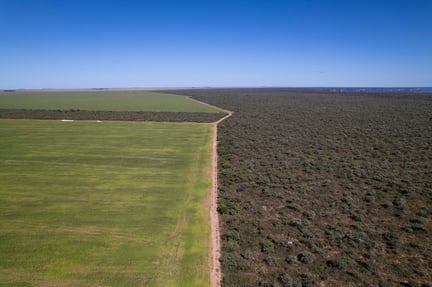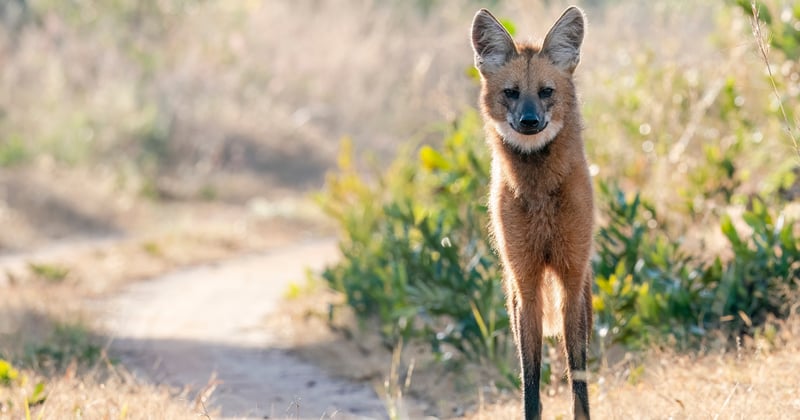
15 fascinating maned wolf facts
Blog
Maned wolves are commonly mistaken for foxes and wolves. But this unique animal species is neither. Read our top maned wolves facts to learn about these elusive, long-legged creatures.
Learn more about these 'foxes on stilts'
Maned wolves belong to the canine family and are the largest canine in South America. They play an important role in their grassland habitat, helping to spread seeds and control small mammal populations.
But few people know much about these striking but solitary animals. Here, we put that right, with 15 fun facts about maned wolves, revealing maned wolf habitat, diet, behaviour, and some of the threats they face in the wild.
Discover 15 incredible maned wolf facts
1. Maned wolves aren't actually wolves - or foxes
Maned wolves are often mistaken for wolves (owing to their name) and for foxes (owing to their appearance). Maned wolves do look like a cross between a fox and a wolf, it's true.
They have long, slender legs and bodies, fluffy tails, and a mane that runs down the back of their necks. Their colouring is similar to that of a fox but their size is similar to that of a wolf. They are sometimes referred to, affectionately, as a 'fox on stilts'.
So, what are maned wolves? Neither wolf nor fox, maned wolves are the only members of the genus Chrysocyon, which means 'golden dog' in Ancient Greek. A maned wolf's scientific name is Chrysocyon brachyurus.
2. Maned wolves are speedy and agile
Maned wolves measure about 90cm (2.95ft) high at the shoulder, making them taller than grey wolves and German shepherds, and the tallest wild canid. A lot of their height comes from their long legs.
'Why do maned wolves have long legs?', we hear you ask. Maned wolves tend to live in grassland habitats. Their long legs help them move through tall grasses while hunting, running, and leaping to catch their prey.
3. Maned wolves only live in South America
Maned wolves are unique to central and eastern South America. They live in Argentina, Bolivia, Brazil, Paraguay, Peru, and possibly Uruguay - although they may now be extinct there.
Maned wolves' habitat typically includes forest, savannah, and grassland.
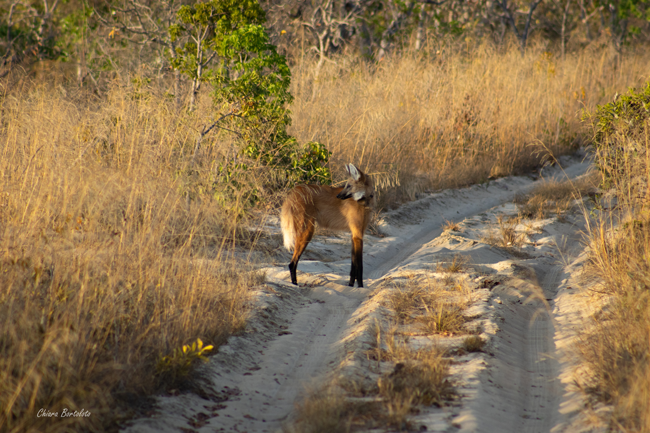
4. Maned wolves' habitat is being destroyed by devastating fires
In Brazil, fires are set deliberately to clear land for factory farming. Once cleared, the land is used to grow crops that feed livestock for the meat and dairy industry.
Land is being set on fire at record levels in areas like the Cerrado and Pantanal which are known for their biodiversity. Millions of wild animals are at risk of injury or death, including maned wolves.
Sorry, we should have warned you, not all maned wolf facts are fun!
5. Maned wolves aren't picky eaters
But next on our list of maned wolf facts is something cheerier: their omnivorous eating habits. Maned wolves diet on birds, fish, and small mammals like wild guinea pigs, rabbits, and burrowing rodents. Maned wolves usually hunt alone, between sunset and midnight, to avoid the heat of the day and interactions with potential predators or competitors.
Maned wolves also eat vegetables, sugarcane, tubers, and fruit. One of their favourite foods is a berry called lobeira (or wolf apple), which looks a bit like a tomato. These apples can grow up to 20cm in diameter and weigh up to 900g.
Scientists believe maned wolves have a mutually beneficial relationship with lobeira berries. These fruits help maned wolves to expel life-threatening kidney worms from their digestive systems. In turn, maned wolves help the lobeira plant by spreading its seeds as they drop faeces across the savannah.
6. Maned wolves are highly intelligent, sentient beings
Just like people, maned wolves are sentient beings. They have thoughts, feelings, and personalities which can be seen in their complex and caring behaviours.
When a female maned wolf is pregnant, she and her partner work together to find a den for her to give birth in. Females have litters of between two and five pups who communicate with their mother by making scratchy, rasping sounds.
During the first few weeks of the pups' life, their father protects the den and brings food. Then, when the pups are older, both mother and father teach their offspring how to hunt. Out of the den, maned wolf parents also warn their pups of danger by howling and barking.
As part of our work with Onçafari, a conservation charity in Brazil, we're getting a privileged insight into maned wolf behaviour. We get to see the close family bonds and varied personalities of the maned wolves we're tracking and supporting in the wild.
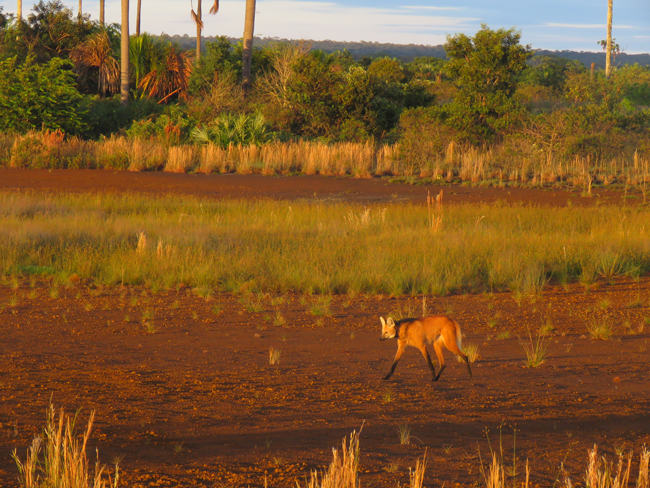
7. Maned wolves mate for life
Can we get an 'awww' for this maned wolf fact?
Pups stay with their parents for up to a year but then the family disbands, meaning maned wolves tend to live on their own. Despite this solitary lifestyle, maned wolves mate for life and return to the same partner each breeding season. Outside this period, couples communicate with typical maned wolf sounds, including loud vocalisations described as 'roar-barks'.
8. Maned wolves help conserve their natural habitat
Did you know that the largest remaining population of maned wolves lives in the Cerrado region of Brazil? This is the largest and most biodiverse savannah in the world. But it's also one of the most threatened. The Cerrado is at risk from factory farming, with land being cleared to make way for crops to feed livestock.
Protecting maned wolves helps conserve maned wolf habitat - like the Cerrado. As a keystone species, maned wolves keep pest populations under control and disperse the seeds of native plants, which keeps grasslands growing healthily.
Without maned wolves, savannahs like the Cerrado and the other wildlife that lives there will find it even harder to thrive.
9. Maned wolves have pungent urine
Here's a fun fact about maned wolves: their pee is really smelly! Some people say it smells like the spray from a skunk or even marijuana - to the point that police were called to Rotterdam Zoo to investigate the source of the stench.
Maned wolves use their urine to mark their territory. This smelly substance warns predators to stay away and helps wolves retrace a hunting path or return to buried prey.
10. Factory farming and soy production threaten maned wolves' survival
You know what we said about not all maned wolves facts being fun? You can add this to the list of sad ones.
Only 3% of maned wolves' habitat is inside Brazil's protected areas. The rest is claimed by farmers and agriculture businesses to grow soy and grain, which is then used to feed the billions of animals kept on factory farms worldwide.
Not only do the factory-farmed animals suffer in cruel, cramped, and unnatural conditions but Brazil's wild animals - including the maned wolf - suffer as a result, too. They have to escape from fires set deliberately by the farming industry, sometimes relocating their pups and dens under extreme stress.
Maned wolves also become trapped in irrigation ditches created by farmers. These have steep sides and are lined with slippery plastic that prevents fallen maned wolves from escaping. Instead, they drown in the ditch.
11. Maned wolves face many other threats too
Maned wolves are becoming increasingly rare and are listed as 'Near Threatened' on the IUCN Red List. That means the maned wolf is likely to qualify for an endangered category in the near future.
Without urgent action, their situation is unlikely to improve. Besides factory farming and habitat loss, maned wolves face other challenges to their survival, particularly as they are driven closer to human populations.
Other maned wolf threats include human persecution. These animals are killed as retaliation for livestock losses. Some people also kill them because of long-standing cultural beliefs.
Many maned wolves are killed by vehicles, as roads increasingly encroach on maned wolf habitat. They are now more likely to contract disease from domestic animals, including dogs. Water scarcity and food availability, thanks to climate change, are also making things tougher for maned wolf populations.
12. Maned wolves are excellent runners
Maned wolves can run very quickly in short bursts. They can reach speeds of up to 48 km/h when chasing prey or escaping predators like pumas and domestic dogs.
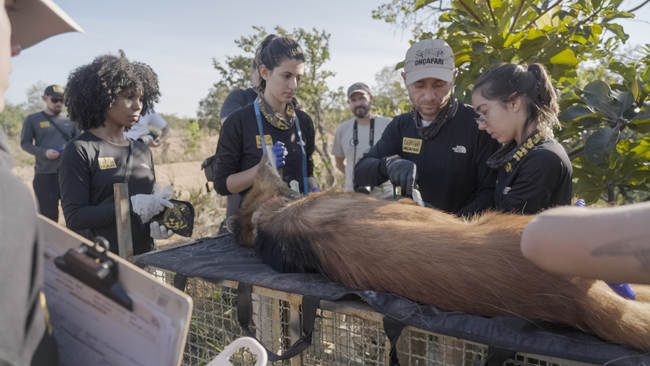
13. But they aren't natural climbers
Maned wolf adaptations - including those long legs, their great eyesight, and excellent hearing - make them well-suited to hunting small prey in open environments. And despite there being plenty of food in the rainforest, maned wolves aren't able to climb trees to reach it. This is why you're more likely to find them in grasslands than in forests.
14. Maned wolves belong in the wild
Maned wolves may be cute to look at but you can't keep them as pets. Maned wolves are wild creatures who prefer a solitary existence and don't enjoy living alongside humans.
In captivity, maned wolves are susceptible to diseases and parasites spread by domesticated dogs. It's also very difficult to recreate the natural maned wolf diet, which can lead to bladder and kidney problems for the animal.
The exotic pet trade is cruel. Whether animals have been taken from the wild or bred in captivity, forcing them to live alongside humans restricts their natural behaviours and instincts.
15. There are fewer than 17,000 maned wolves left
We hate to end on a concerning note but this maned wolf fact can't - and shouldn't be - ignored.
According to the IUCN, there are fewer than 17,000 mature maned wolves. The largest population can be found in Brazil - and there are just a few hundred maned wolves in countries like Argentina and Paraguay. In Peru, there are less than 40 individuals.
Scientists believe that several hundred wolves are needed for a population to maintain its genetic diversity and long-term survival. And losing just one maned wolf is a tragedy because this species doesn't find it easy to reproduce. Females can go up to two years without breeding and pups experience a high rate of infant mortality.
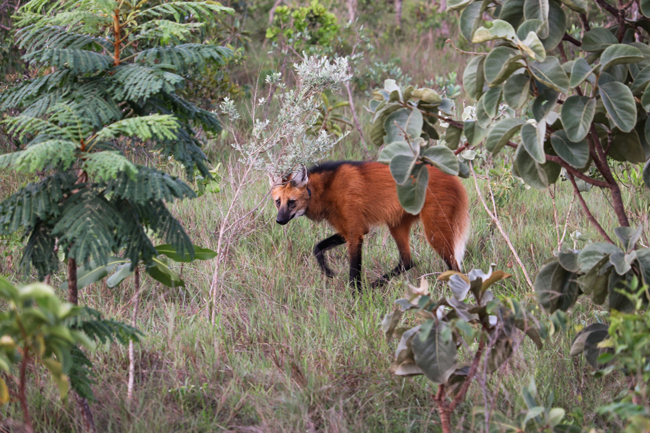
How to help maned wolves
We hope this maned wolf information has helped you get to know and appreciate these unique animals a little better.
At World Animal Protection, we're working hard to protect maned wolves. We launched a two-year maned wolf monitoring project alongside our partners at Onçafari, donating vital equipment, including radio collars, camera traps, and a drone.
With this equipment, we're monitoring maned wolf populations in Brazil's Bahia state and the Cerrado biome. We're learning where these animals can roam and supporting the Onçafari team to respond quickly in case of emergencies.
The data we gather about maned wolves and the threats they face will be critical in convincing the Brazilian government and farming industry to do more to protect this near-threatened species and the grassland habitat they call home.
With our support - and with the support of wildlife lovers around the world - we can ensure the survival of maned wolves, so they can continue to support their savannah ecosystems.
Wondering how to help maned wolves and protect them from the many threats they face? You can support maned wolf conservation by subscribing to the World Animal Protection newsletter.
Join our global community of animal protectors today.
Related content
Irrigation canals cause harm to wildlife in Brazil
News
"Invisible Massacre," an investigation by O Eco with World Animal Protection Brazil, reveals how irrigation canals harm Brazil's wildlife.
JBS’s Cruel Factory Farming Empire
Discover the hidden costs of meat processing and factory farming by JBS, the world’s largest producer. Take action today!
16 fascinating jaguar facts — learn more about the third biggest cat in the world
Blog
Big cats are more than just lions and tigers, enjoy our captivating jaguar facts.

